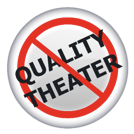Unlike us humans, documents are not created equal. Among the millions of electronic documents stored on disk somewhere only a few are critical to quality and compliance. We call them by many names: quality manual, standard operating procedures (SOPs), work instructions, policies, guidelines, official templates, and more. Despite their smaller volume, managing them is a ton of work. Just like a signed contract embodies a binding relationship between two companies, an effective SOP embodies how a key process is repeatedly run with high quality, compliance and safety to all parties. A Big Quality Document is so much more than a nice-looking PDF – someone’s life might actually depend on the document being good, its contents known, and systematically followed.
The Manual Process in the Cloud Age
The good principles for handling the Big Quality Documents emerged before the modern IT age. There was just paper, binders, wet-ink signatures, stamps, filing cabinets and knowledgeable people. Today, many companies still follow similar manual process, as if nothing has changed other than typewriters becoming laptops. People manually move Word, Excel and PDF documents between storage locations and attach different versions to endless emails. They print documents on paper for signing and chase signers around the organization. They archive signed paper originals somewhere but keep scanned copies for daily use. They distribute numbered printouts on the factory floor, lab and cleanroom. They publish effective documents on the Intranet with high hopes that someone actually reads them or trains them to staff. That’s 1980’s computer technology all over.
If there are enough skilled resources to run such a manual process, then quality might be fine as such. But the process is hopelessly inefficient and prone to error. How could we improve? What do quality-document-related computer systems actually DO for us, other than just provide disk space?
Towards true digitalization of Quality Document Control
True digitalization in quality document control means that the computer systems will ensure your good document process. A good document control system will empower key people, make them more efficient, and act as their vigilant secretary – so knowledgeable people can focus on the content of those documents. Need to provide unique number for each document? Need to stamp that number on page 1 of every document? Need to ensure the correct process owners always have a say in the workflow before document is published? Need to make sure staff will only access the current effective version? When you retire a document, need to ensure it’s no longer used anywhere? All these should be jobs for a vigilant computer system, not people.
So, what kind of tools we should look for? Consider these:
- Any quality document system worth a penny should handle basics like ensure each document has a unique number or ID, have full version history, and ensure that the approved documents remain untouched. If a system fails to meet even such elemental requirements, just walk away.
- A good quality documents system captures large portions of the document life-cycle without the need to move documents around. Why should we need to author documents in one system, review and collaborate in another, sign with a third system (or paper), publish the approved document in fourth, learn the key documents in fifth, and finally archive the document in sixth. Look for systems that cover many steps of the document process in just one system.
- Never attach a draft document to an email. Emailing documents around will not only bloat your email system but also leave various versions all over the place, effectively ensuring that authors are never 100% sure they’re looking at the correct version. Instead, only put a document link into the email, and let users always find the latest version through the link. If your current system doesn’t easily support that, of if those hyperlinks get broken all the time, consider a better system.
- Avoid processes that revolve around one key person. Favor computer systems that allow picking up from the person who just suddenly isn’t available. No matter how good, experienced or committed your quality document controller is, relying on just one person is a business continuity risk.
- Paperless eSigning is a must! Ensure efficiency and allow capturing signatures 24/7 on several devices, including smartphones. For most quality documents the electronic signatures are regulatory compliant and thus ‘good enough within the company’ while in some cases we need true digital signatures that could be even legally binding. Look for systems that handle either of these signature types with ease and can manifest the signatures on the resulting document.
- A good document control system not only stores and controls those big documents but also helps you orchestrate the tasks around them. Favor systems that have means to make key people aware of what documents await their contribution or approval signature.
- Quality documents often reference or impact other documents that relate to the same process. A good system makes you aware of these relationships and allows you to judge whether a change in one document also impacts another process and its documents.
- Quite often a Big Quality Document is not a single file but a collection of related items. For example, an instruction might be accompanied with a checklist or template that is filled when you follow the instruction. Or, perhaps you need to maintain a safety instruction in several languages in order to reach all the staff with different language skills. Favor systems that understand the notion of supporting documents, document packages or controlled attachments (the terminology varies between systems).
- Having quality documents just sit in the Intranet untouched for years is not ok. Favor a computer system that can enforce periodic document review, provides reminders and allows easy recording of the review outcome. Once again: computer system should be your vigilant secretary.
- Often documents are created from official templates. A good computer system can manage these templates and make sure people easily find the current templates when creating new documents.
- Different regions and different industries think differently about where to host their key systems. Often both the IT and Finance favor the Cloud but there are concerns, too, sometimes due to aging regulations that was created before there was Cloud. Favor systems that can be hosted in a flexible, future-proof manner. And, if the original hosting choice turns out to be an issue later, allow migrating the system from your own server room to Cloud or vice versa.
- Make sure the document control system complies with the laws and regulations of your industry. For example, in Food and Beverage the relevant ISO, FDA, EU and HACCP regulations give a lot of room for choosing the computer tools of your choice, while in highly regulated business the systems themselves need to have certain qualities, and these qualities need to be demonstrated in formal system validation.
- In certain highly regulated businesses, all changes to the documentation, including creating a new document, should be controlled by a document change request process. Some computer systems support this process, in case your organization needs it.
- Do not make all design choices based on the need of quality managers and other power users. Think of the casual user whose daily work has little to do with quality documents. The casual users might have the best substance knowledge on many topics, but they seldom visit the big document system. Look for systems that make things as easy as possible for the infrequent user. If these users need to actively search for documents that await their action, the process will very likely not work.
- Last but not least: having an Intranet or a binder full of fancy, quality-oozing
 documents is all but Quality Theater unless people actually learn those documents and following them leaves some auditable records behind. These are two HUGE topics that we will discuss more later in our blog series. In a nutshell: seek computer system that help you track document learning. Consider where the evidence is recorded when people actually follow your Big Quality Documents. Yes, we will return to these topics!
documents is all but Quality Theater unless people actually learn those documents and following them leaves some auditable records behind. These are two HUGE topics that we will discuss more later in our blog series. In a nutshell: seek computer system that help you track document learning. Consider where the evidence is recorded when people actually follow your Big Quality Documents. Yes, we will return to these topics!
The Wrap: let’s get out of the 1980’s
Businesses should demand more of the quality document systems. The big dinosaur ECM’s that used to be the ‘industry gold standard’ systems are fading away, and the more modern and affordable systems that claim to replace them often do nothing more than allow uploading documents you have created elsewhere. Surprisingly many businesses still follow a fully manual process for their key quality documents, with senior employees doing dull secretarial work. We use some great software tools in many parts of our business, but quality document control has mysteriously been left in the 1980‘s. It’s time to demand better tools!
Want to see how to automate many steps of the quality document control? Want to see some true digitalization and process automation? Read more about our QMS solution, below you can download our infographic "Quality Document Control - Challenges". In the paper we discuss how to improve Quality Document Control with intelligent information management and process automation.

